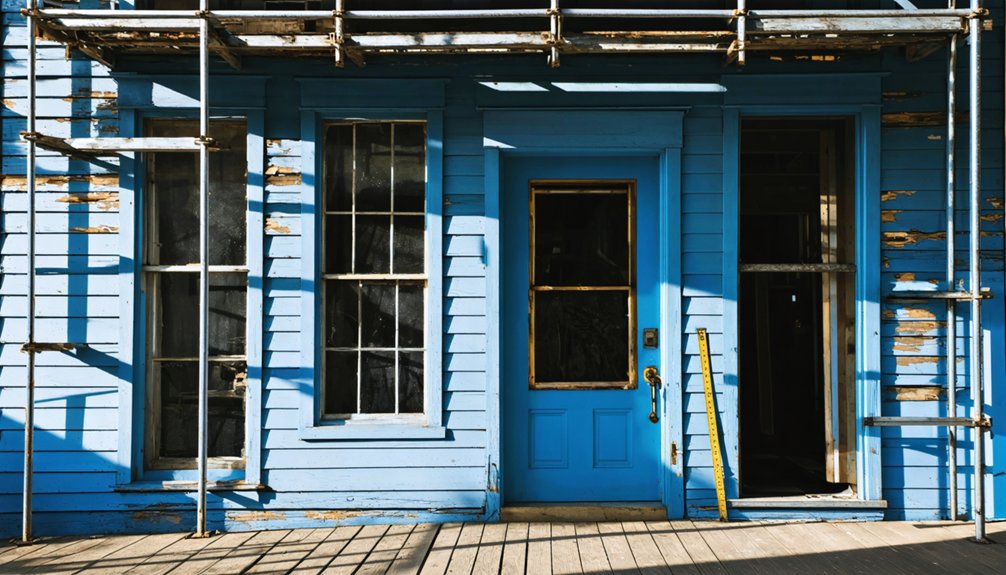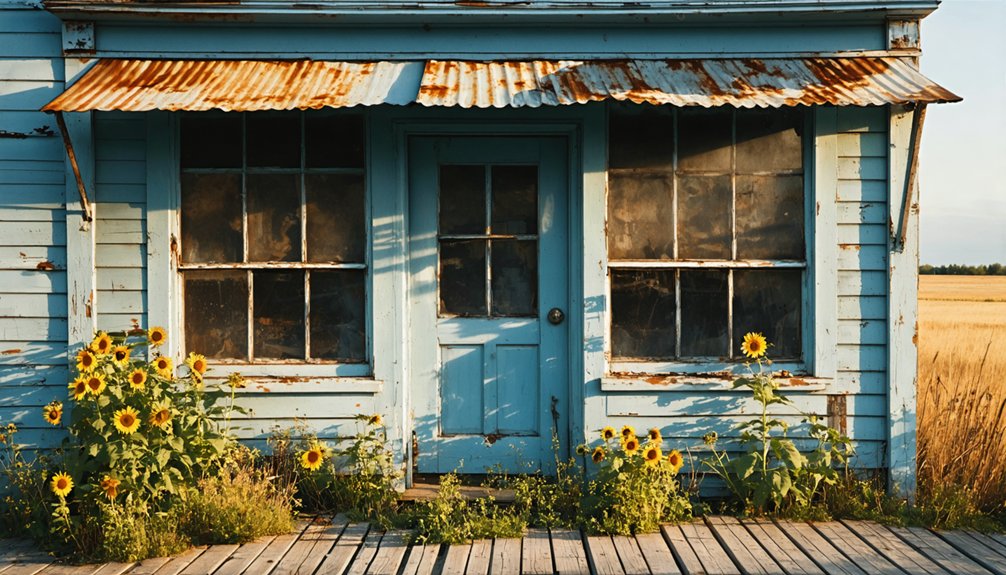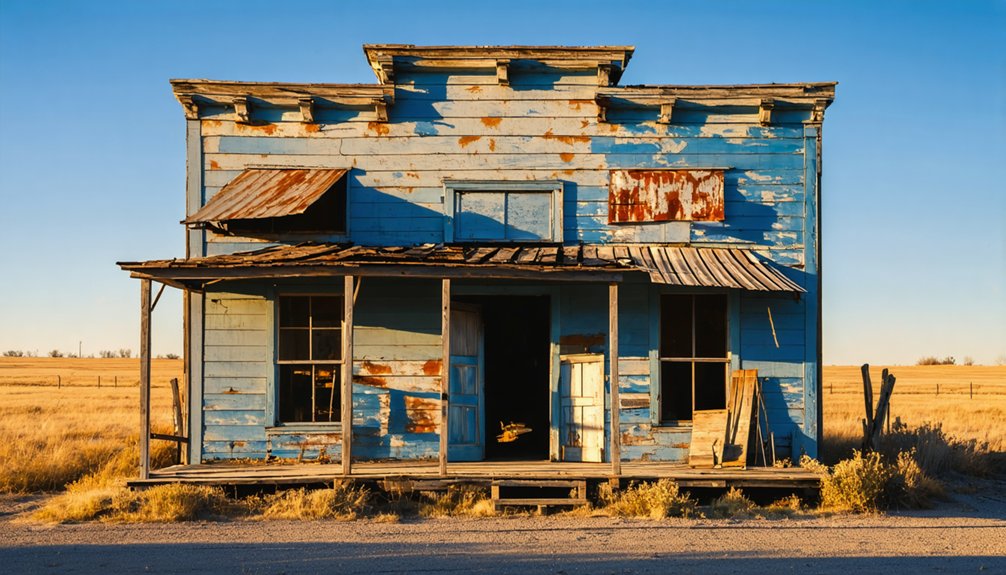You’ll find Gregory nestled in South Dakota’s Black Hills, established in 1879 following Charles Dunphy’s Montana Mine discovery. The town cycled through several names, including Elk Creek and Montana City, before settling on its final identity. While mining operations initially drew settlers, the challenging landscape and limited accessibility led to its eventual abandonment. Today, the IOOF Cemetery’s ghost stories and the Gregory County Historical Society’s preservation efforts keep the town’s pioneering spirit alive.
Key Takeaways
- Gregory was established in 1879 after Charles Dunphy discovered the Montana Mine, drawing settlers with promises of mineral wealth.
- The town underwent several name changes, from Elk Creek to Elkhorn City, then Carterville, Montana City, and finally Grandview.
- Limited accessibility and challenging landscape contributed to the town’s eventual decline and ghost town status.
- The IOOF Cemetery, established in 1910, hosts annual Cemetery Walk Events featuring actors portraying past residents.
- Paranormal activity reports include ghost sightings at the cemetery and near local landmarks like “the Buttes.”
Origins and Early Settlement
While many Black Hills ghost towns share similar origin stories, Gregory’s establishment in 1879 began with Charles Dunphy’s discovery of the Montana Mine. The promise of mineral wealth quickly attracted settlers, leading to a $160,000 investment in a mill to process the ore using advanced mining techniques for that era.
Like many towns in the Black Hills region, Gregory’s story illustrates how mining operations could rapidly transform untamed wilderness into bustling settlements.
Initial settlers were driven by dreams of prosperity, much like those who came to South Dakota under the Homestead Act of 1862.
You’ll find Gregory’s early settlement demographics centered entirely around the mining operation, with workers and their families establishing homes in the rugged terrain.
The town emerged as part of a cluster of small settlements, including Elk Creek, Elkhorn City, and Montana City, creating some confusion about exact boundaries. Local businesses sprouted up to serve the mining community, though the challenging landscape and limited accessibility made sustaining a large population difficult from the start.
The Evolution of Town Names
Like many frontier settlements in the Black Hills, the town now known as Gregory underwent several name changes that reflected its evolving identity and aspirations.
Frontier towns often changed their names as communities evolved, each new identity capturing the dreams and spirit of its era.
You’ll find its earliest reference as Elk Creek, named for the waterway that flowed through the area. The settlement evolution continued as it became Elkhorn City, possibly indicating a period of growth or formalization.
Later, it transformed into Carterville, though records don’t reveal the namesake behind this change. A brief stint as Montana City followed, not to be confused with the Lawrence County ghost town of the same name. Like many ghost towns of its era, the site now stands in various states of disrepair.
Finally, the settlement adopted its last known name, Grandview, before fading into history. Each name change marked distinct phases in the community’s development and eventual decline. The town’s location within Gregory County’s 1,004 square miles made it one of many small settlements that dotted this vast frontier territory.
Native American Heritage and Conflict
Before Gregory became a ghost town, it stood on land that held deep significance for Native American peoples, particularly the Lakota Sioux.
You’ll find this area was once part of the Great Sioux Reservation, established by the Fort Laramie Treaty, but later diminished through illegal land seizures and the devastating Dawes Act of 1887.
The Native heritage of this region centers on sacred sites like Buffalo Butte and its legendary cave, believed to house the White Buffalo spirit.
However, this cultural landscape became a battleground as Fort Randall’s soldiers enforced policies pushing Native Americans from their ancestral lands.
The conflict resolution attempts largely failed, as government policies focused on assimilation rather than preservation, resulting in the loss of 90 million acres of Native lands through forced sales and exploitation.
The Ponca Trail of Tears in 1877 marked another tragic chapter in the area’s history of forced Native American displacement.
Cemetery Tales and Local Legends
If you’re visiting Gregory’s IOOF Cemetery, established in 1910 to replace Ben Lancaster’s earlier burial grounds, you might encounter the oft-reported spirits of an elderly man wandering among headstones or a young soldier sitting beneath a tree.
The cemetery’s ghostly tales have become central to local culture, with the Gregory County Historical Society hosting cemetery walks that blend paranormal stories with historical education. Similar to De Smet’s traditions, these walks feature community actors portraying past residents.
These community events bring the town’s ancestors “back to life” through dramatizations, while preserving the rich legacy of Gregory’s early settlers. The first burial ceremony took place on April 30, 1911, when Everett Powell was laid to rest.
Historical Burial Ground Development
When the Odd Fellows established the IOOF Cemetery in Gregory during 1910, they laid the foundation for what would become one of South Dakota’s most historically significant burial grounds. They invested $1,000 in ten acres of land, shaping the cemetery architecture that would honor generations to come.
You’ll find that burial traditions evolved as homesteaders relocated their family graves from farmsteads to this central location. The first burial, Everett Powell in 1911, marked the beginning of a community legacy that continues today. Like Fort Randall Cemetery, many graves tell stories of those who succumbed to harsh frontier conditions.
Through careful surveying and strategic lot sales, the cemetery expanded while maintaining its historical integrity. Veterans’ graves, including World War I soldiers like Alfred Hutchison, stand as silent reminders of sacrifice, while Shafer Memorials guarantees these stories aren’t forgotten. Today, visitors can access a fillable PDF form to assist with memorial planning and cemetery inquiries.
Ghostly Cemetery Encounters
Beyond its historical markers and memorials, the IOOF Cemetery holds another layer of Gregory’s heritage through its documented paranormal activity.
You’ll find two distinct spirits frequently reported by visitors: an elderly white-haired man searching among the headstones and a young soldier who appears beneath a specific tree during daylight hours.
These encounters have sparked a rich tradition of spectral folklore, preserved through the Gregory County Historical Society’s cemetery walks and oral interpretation events. The tales contribute considerably to paranormal tourism while reinforcing the community’s connection to its past.
Unlike many haunted locations in South Dakota that come alive at night, IOOF Cemetery’s apparitions boldly manifest in broad daylight, making it a unique destination for those seeking supernatural encounters. Local historians note that Seth Bullock’s ghost is occasionally spotted visiting from nearby Deadwood, adding to the cemetery’s mysterious reputation.
Community Cemetery Walk Events
Since its inception in 1910, the IOOF Cemetery has become the cornerstone of Gregory’s historical storytelling through its annual Cemetery Walk Events each September.
The cemetery’s significance extends beyond its role as a burial ground, serving as an outdoor classroom where you’ll witness oral interpretation students bringing local ancestors to life through first-person narratives.
You’ll discover the rich tapestry of Gregory’s pioneer heritage as students portray influential residents who shaped the town’s development.
The walks blend documented history with cultural folklore, featuring tales of ghostly sightings and legendary figures while emphasizing community engagement through shared remembrance.
Through these interactive presentations, you’ll connect with Gregory’s founding families and notable personalities, experiencing how the cemetery grounds preserve the legacy of early settlers who established this South Dakota community.
Ghost Stories and Paranormal Activity
Although Gregory’s ghost town status naturally lends itself to tales of the supernatural, the town’s documented paranormal activity remains relatively modest compared to other haunted locations in South Dakota.
You’ll find the most notable ghost sightings at the Independent Order of Oddfellows Cemetery, where apparitions have been spotted even during daylight hours.
While locals occasionally report unexplained phenomena near landmarks like “the Buttes,” these encounters typically involve brief visual appearances rather than elaborate hauntings.
Brief ghostly sightings near Gregory’s Buttes remain fleeting glimpses, never developing into the complex hauntings found elsewhere.
Unlike the rich paranormal lore of Deadwood or Sioux Falls, Gregory’s supernatural history consists mainly of simple cemetery apparitions and unexplained incidents.
You won’t find famous historical ghosts or extensively documented hauntings here, but the town’s multiple historical names and abandoned buildings add an authentically eerie atmosphere to your visit.
Historical Preservation Efforts

You’ll find the Gregory County Historical Society actively preserving the town’s heritage through their signature Cemetery Walk programs, where students bring historical figures to life through interpretive performances at the IOOF Cemetery.
The Society maintains extensive archives documenting early settlers, town development, and extinct settlements while serving as an essential resource for genealogical research.
Through oral histories and community memory documentation, they’re creating a lasting record of pioneer life, local conflicts, and migration patterns that shaped Gregory’s history.
Cemetery Walk Programs
Through the dedicated efforts of the Gregory County Historical Society, cemetery walk programs at the IOOF Cemetery have become a cornerstone of historical preservation in Gregory.
You’ll find local high school students bringing history to life through oral interpretations, portraying deceased residents and sharing their stories in first-person narratives.
These cemetery preservation initiatives highlight Gregory’s cultural heritage through:
- Student-led historical storytelling that features authentic accounts of early settlers
- Community engagement events that attract history enthusiasts and tourists
- Educational collaborations between schools and the Historical Society
- Interactive programs that showcase local legends and notable residents
The walks don’t just preserve history – they create a living connection between past and present, ensuring Gregory’s rich heritage continues to inspire future generations while supporting ongoing preservation efforts.
Historical Society Archives
Several dedicated organizations work tirelessly to preserve Gregory’s rich historical legacy through extensive archival initiatives. The State Archives manages over 12,000 cubic feet of historical records, while the Gregory County Historical Society maintains crucial local collections, including maps of original towns and ghost towns.
You’ll find remarkable archive accessibility through the South Dakota Digital Archives, hosting more than 70,000 digitized items that you can explore from anywhere.
The preservation challenges are met head-on through microfilm preservation of the Gregory Times-Advocate newspaper and careful documentation of rural schools.
These combined efforts by state and local organizations guarantee you’ll have access to Gregory’s past through photographs, manuscripts, maps, and government records – all meticulously preserved for future generations to study and understand.
Community Memory Documentation
While official records tell part of Gregory’s story, the heart of its historical preservation lies in the community’s collective memory.
Through community narratives and oral traditions, you’ll discover intimate details about daily life, local events, and the town’s eventual decline that aren’t found in formal documents. Local elders and longtime residents share firsthand accounts that bring Gregory’s past to life.
- Regular community gatherings revive and record shared memories
- Family stories illuminate the reasons behind the town’s transformation
- Local knowledge helps identify unmarked locations and forgotten places
- Resident interviews fill essential gaps in the historical record
The preservation of these community memories, combined with historical photographs and surviving structures, creates a more complete picture of Gregory’s legacy – one that continues to resonate with those seeking to understand South Dakota’s ghost town heritage.
Tourism and Cultural Events

Gregory’s rich historical heritage attracts tourists through a diverse range of attractions and cultural events that showcase South Dakota’s pioneer spirit.
You’ll discover nearby ghost towns featuring preserved buildings, church-jail combinations, and converted railroad trails that bring the Old West to life. The region’s ghost town tourism thrives from May through October, offering you interactive experiences like live melodramas, historical reenactments, and costumed tours at sites like 1880 Town.
While exploring this cultural heritage, you can enjoy gemstone panning, craft fairs, and cowboy-themed activities. Modern amenities support your visit, with RV parking, lodging options, and smartphone-guided tours.
The area’s proximity to Mount Rushmore and Badlands National Park makes it an ideal stop on your South Dakota adventure.
Black Hills Ghost Town Legacy
Throughout the late 19th century, the Black Hills region witnessed an extraordinary surge of boomtowns following the momentous gold discovery of 1874.
Ghost town architecture reveals the diverse foundations of these communities, from mining camp culture to railroad hubs and resource extraction sites. You’ll find remnants of a vibrant past where entrepreneurs built thriving communities around gold, coal, limestone, and cattle shipping.
The Black Hills ghost towns showcase distinct patterns of rise and decline:
- Initial settlements sprang up rapidly, with lot prices ranging from $10-$60
- Towns developed extensive services, including stores, churches, and medical facilities
- Economic diversity emerged through various industries like coal mining and limestone quarrying
- Abandonment occurred gradually, often due to resource depletion or transportation shifts
These silent sentinels stand as testimony to the region’s pioneering spirit and economic evolution.
Frequently Asked Questions
What Was the Population of Gregory During Its Peak Years?
You’ll find Gregory’s population trends reached their historical significance during the 1970 Census when the community hit its peak at 1,756 residents, marking the town’s most populous period.
Are There Any Remaining Original Buildings Still Standing in Gregory Today?
You’ll find several abandoned structures still standing along Gregory’s Main Street, though they’re privately owned and deteriorating. No active historical preservation efforts exist to maintain these original buildings today.
What Industries or Businesses Were the Main Economic Drivers in Gregory?
Like a gold rush dream turned to dust, you’d have found mining as the primary driver, supported by railroad connections and limited agricultural development until the mine’s closure in 1941.
How Accessible Is Gregory to Visitors, and Are Guided Tours Available?
You’ll find Gregory easily accessible by car via SD-47, with basic visitor amenities like motels and cafes available. However, there aren’t any organized ghost tours – you’re free to explore independently.
When Did the Last Permanent Residents Leave the Town of Gregory?
You won’t find exact records of the last residents leaving, but town history suggests permanent inhabitants departed by the mid-1900s, with the community definitively recognized as abandoned by the 1970s.
References
- http://www.gregorycountyhistoricalsociety.com/GCHS-blog/uncategorized/ghosts-comes-to-life-in-gchss-cemetery-walk/
- https://www.sdpb.org/rural-life-and-history/2023-08-21/some-black-hills-ghost-towns-and-their-origins
- https://www.sdhspress.com/journal/south-dakota-history-2-2/some-black-hills-ghost-towns-and-their-origins/vol-02-no-2-some-black-hills-ghost-towns-and-their-origins.pdf
- https://genealogytrails.com/sdak/gregory/history.html
- https://en.wikipedia.org/wiki/List_of_ghost_towns_in_South_Dakota
- https://b1027.com/south-dakota-has-an-abundance-of-ghost-towns/
- https://www.youtube.com/watch?v=Glucs_Rq8Xs
- https://core.ac.uk/download/pdf/345016075.pdf
- https://www.southdakotamagazine.com/gregory-county
- https://www.ghosttowns.com/states/sd/gregory.html



